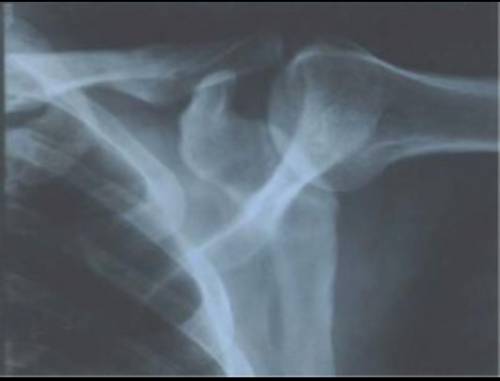
Biology, 15.11.2020 20:20 rawaanasser12245
An athletic was playing footbal one evening. Later, he was slammed backwards into the upright edge of the penalty box. The jolt pushed the head of his humerus forward, dislocating his right shoulder. He turned around and slammed his own arm against the wall so that the humerus was pushed back into place. For several weeks afterwards the range of motion in his right arm was much less than on the left. He did not tell his parents what happened or they would have taken him to see an orthopedic surgeon.
1. With the help of the x-ray describe the bony structures of the shoulder joint.
2. Define range of motion (ROM) and
explain how the bony structure of the
shoulder normally allows for a large range
of motion.
3. Define stability and explain why the structure of the shoulder does not give it great inherent stability.
4. Discuss the structures (e. g., ligaments and cartilage that are important to keeping the humeral head in the glenoid cavity.
Specifically, what structures prevent anterior displacement of the humeral head?
5. Suggest how these structures may have been overcome resulting in dislocation of the humerus


Answers: 2


Other questions on the subject: Biology

Biology, 21.06.2019 13:20, egyptforrest9892
Compare and contrast the relative importance of the sporophyte vs gametophyte generation between nonvascular plants (bryophytes), seedless vascular plants and seed plants, and explain the ecological significance of a larger sporophyte generation
Answers: 1

Biology, 22.06.2019 15:30, Calebmf9195
(me out over the last several centuries, scientists have made the following broad observations while investigating several branches of the life sciences: -the fossil record shows that different types of organisms have existed at different times in earth's history. -many organisms have similar body structures that seem to be adapted to different ways of living in their environment. -organisms of different species often share similarities in stages of embryonic development. -many species share genetic similarities, and almost all organisms use the same basic building blocks to construct proteins. -often, the extent of two species' similarities can be predicted from their geographic closeness to each other. -a great deal of change has been observed among species that have experienced strong selective pressures through many generations. scientists have carefully considered and rigorously tested the observations listed above. when scientists offer a of these observations, they are making 1.) testable explanation, deductive explanation 2.) scientific interference, scientific law
Answers: 3

Biology, 22.06.2019 19:30, antionette1
Can someone give me the answer to this question? you so much
Answers: 1

Biology, 22.06.2019 23:00, calebwoodall6477
You are studying several alleles of an e. coli helicase gene. one allele, called rsr, confers resistance to rs2014, an antibiotic that works by inhibiting helicase activity. bacteria with the rss allele are sensitive to rs2014. another allele, called ts-, produces a temperature sensitive mutation of the helicase. in bacteria with the ts- allele, helicase is inactivated at 42 °c but functions normally at 37 °c. helicase functions normally at both temperatures in bacteria with the ts allele. you obtain the following data while testing four strains of e. coli at different temperatures and doses of rs2014. each number represents the percentage of maximal dna synthesis. based on this data, assign the appropriate genotype to strains a–d in the spaces provided
Answers: 1
You know the right answer?
An athletic was playing footbal one evening. Later, he was slammed backwards into the upright edge o...
Questions in other subjects:


Biology, 13.01.2021 14:00


Mathematics, 13.01.2021 14:00

Biology, 13.01.2021 14:00


Mathematics, 13.01.2021 14:00

Law, 13.01.2021 14:00

Mathematics, 13.01.2021 14:00

Biology, 13.01.2021 14:00



